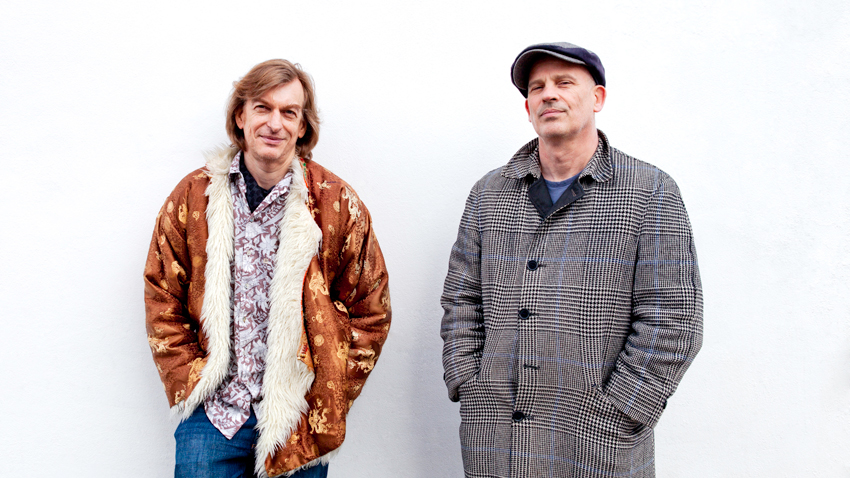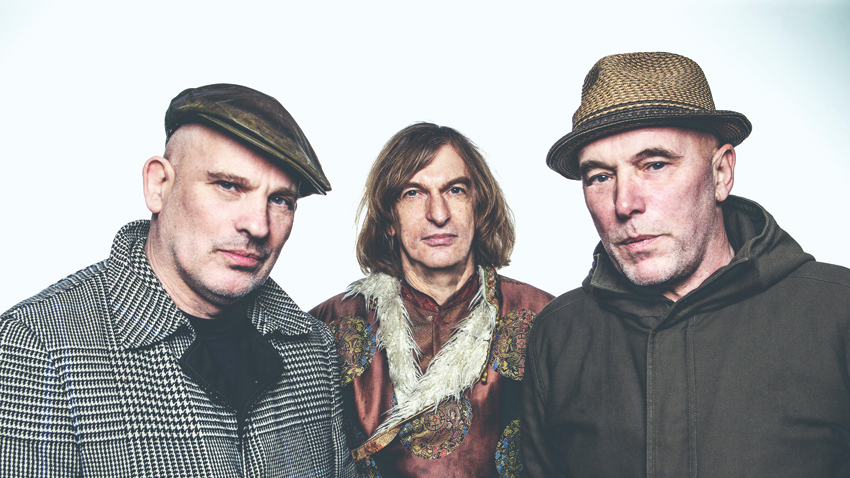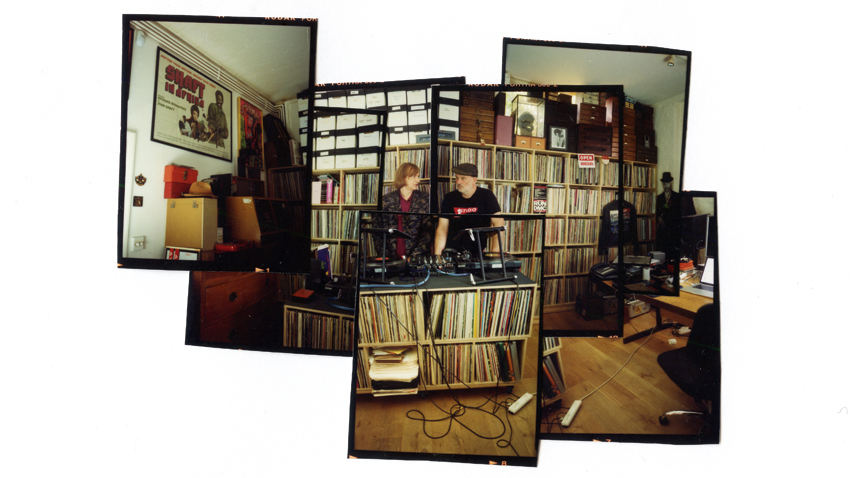Coldcut’s Jonathan More on the production of Outside The Echo Chamber
The sampling innovators are back with a new dub album, produced in collaboration with the equally legendary Adrian Sherwood

Coldcut’s Jonathan More and Matt Black have packed a lot into their 30-odd year career. Pioneering DJs in the days before acid house. Pioneering producers - their 1987 single, Say Kids, What Time Is It? is arguably the UK’s first sample-based single. Pioneering remixers - even today, the Erik B and Rakim/Ofra Haza mash-up, Paid in Full, still sounds gorgeous. Pioneering pop stars with 1988’s Doctorin’ The House. Pioneering label bosses - in the early 90s, More and Black formed the still-respected Ninja Tune label, variously home to the likes of Bonobo, Roots Manuva and Diplo. And pioneering nerds - they’ve been experimenting with audio-visual software for over 20 years and are just about to follow-up the seriously impressive Ninja Jamm app with some more, er… seriously impressive software.
We’re not finished yet! Their legendary Solid Steel radio shows were broadcast around the globe and they’ve influenced everybody from the Chemical Brothers to DJ Shadow.
More and Black have released a new album, but in true Coldcut fashion, it comes with a twist. Outside the Echo Chamber is a collaborative project with On-U-Sound’s Adrian Sherwood - a remixed, dub-heavy album that you’ll swear was recorded in mid-70s Jamaica.
It was actually recorded in the old-school Kentish seaside town of Ramsgate, home to the Royal Harbour, Albion House Hotel, Palace Amusements and Shakey Shakey Fish Bar… and of course, Adrian Sherwood’s vintage ’n’ analogue-friendly On-U-Sound studio. We caught up wth Jonathan More to find our, er, more…
Was the album recorded in between trips to the beach and the Shakey Shakey Fish Bar?
“Sort of. Haha! We’d start work about noon, go through to early evening, take a walk on the beach, have a pint and some chips, then head back for a last couple of hours. It was all very relaxed… and very quick. We did three or four days a week for a month. That’s what’s great about working with Adrian: there’s no messing about. None of that four-in-the-morning, ‘Does the snare sound OK?’ bollocks!”
Presumably Coldcut and On-U-Sound go way back-– both groundbreaking, bass-hungry, experimental British labels.
Get the MusicRadar Newsletter
Want all the hottest music and gear news, reviews, deals, features and more, direct to your inbox? Sign up here.
“I actually grew up in High Wycombe, which is Adrian’s home town. He was very much the man-about-town; everybody knew Adrian. I’m sure we were at the same concerts together, and I remember being very keen to check out those early On-U-Sound releases. There was a lot of dub around in the 70s and 80s, but this was British dub!
“I guess you could say we’ve known each other for a long time, but we were both busy with our respective lives… as often happens in this business.”
But now you’ve made an album with Sherwood at the controls. Was this always planned as a ‘dub’ project?
“Not at all. We very rarely plan anything. We had a bunch of ideas that were floating around… building blocks for an album. Some were new, some were from the archives. We went over to do a session with Dave Taylor [aka house producer Switch, formerly of Major Lazer and M.I.A producer] and a lot of it came out sounding sort of reggae-ish.
“Just by chance, we were over in Jamaica not long after that, recording some sessions with the likes of Lee ‘Scratch’ Perry, Junior Reid, Ce’Cile, Chezidek. The songs were kind of groovin’ all over the place, but we couldn’t seem to shake this reggae-dub thing. What we needed was someone who could pull it all together.
“Adrian had worked on the last Roots Manuva album, and we knew that he was a master of that… taking disparate elements and making them fit together like a jigsaw. The phone calls were made, everybody was happy, so Matt and I jumped on a train to Ramsgate.”
From Kingston to Ramsgate - it’s a dub exodus!
“The strange thing is that Ramsgate has got this real musical-creative buzz going on. Adamski lives down there, Doug Wimbish and Skip McDonald were hanging out. It was such a lovely way to work on an album. Having a laugh and making music by the sea. That’s what it’s all about.”
You said this was a collection of old and new ideas, but how does Coldcut ‘songwriting’ work these days? It sounds like a very live album.
“There are still some samples in there, and occasionally it can be a sample that will spark the idea for a song. As always, a lot of songs will appear when you’re just messing about in the studio.
“At one point, I had this idea of trying to write a fully programmed dub song in MIDI. Y’know, actually clicking in all the echoes and off-kilter hi-hats. It didn’t always work out as I thought it would work out, but from there, there might be a great bassline or a lovely set of chords. Songs tend to be combinations of different ideas and approaches… and different people.
“Yes, there is a lot of ‘live’ stuff on here. Luckily, Skip and Doug were knocking around. Skip is such a musical genius; such a great ear. There were various arrangements that Matt and I had worked on, but when Skip got stuck in, he really brought things to life. He’d say, ‘This is OK, but this note should be such-and-such a note’. Suddenly, it would make sense. ‘Oh, yeah. That’s what it’s supposed to sound like’.”
There are still some samples in there, and occasionally it can be a sample that will spark the idea for a song. As always, a lot of songs will appear when you’re just messing about in the studio.
Did you set any rules for Adrian?
“Only to be as crazy as he wanted to be. Mash it up, mate! We got Celloman [aka Ivan Hussey] in to do some strings for us. They sounded fantastic to start with, but then Adrian stuffed them through his Eventide H9 Harmonizer and… wow! Analogue meets digital; man meets machine. Stunning! I love it when stuff like that happens in the studio. Sounds that you could never imagine.”
We were at Adrian’s studio a few years ago. It’s analogue heaven down there. What’s the Coldcut setup these days?
“It’s pretty much in the box, almost all in Ableton, which I think is a wonderful platform. And not many extra plugins: Massive, Looperator, Rough Rider, Regroover, Reaktor, Quad Frohmage, plus Alchemy, CamelCrusher and one or two other Camel goodies. And Midivolve, of course, which is one of the new apps we’ve been working on.
“I’ve been working on Ableton for years and, to be honest, I was very happy with that. But when we were planning to go out to LA with Dave Taylor, I thought it was time to brush up on a bit of Logic - Dave’s a Logic man. We transferred some stuff completely to Logic and also worked with Ableton and Logic ReWired.
“It’s the first time I’ve got to know my way around Logic and… yeah, some of the stuff I like and some of the stuff got on my nerves. Creatively, I don’t think you can beat Ableton, but when it came to recording live stuff – especially live bass – I seemed to prefer Logic.”

You’re not the first person to say that.
“And the important thing about working with live bass is that, production-wise, the whole bassline suddenly becomes a lot simpler. Do you know what I mean? If you’re working with synths or plugins, you’ve got a million different bass sounds to choose from; you can spend a day just deciding how you want to layer different sounds and tones. With a bass guitar, you’ve only got one thing to worry about: the bass guitar. That’s it. That’s your bass sound.
“Yes, there are a lot of producers who swear by certain frequencies for your bottom end, but I’ve never been one of those people who bring it all down to numbers. For a start, it’ll depend on what else is in the track and what you’re mixing on. Are you mixing it for the club or iTunes?
“I personally prefer to rely on my ears and mix something for ‘me’. Do I like it? If you need a different mix for Radio 1 somewhere down the road, get somebody to do you a Radio 1 mix. If you’re trying to cover every angle, you’ll end up going around in circles. It’s your music… mix it for you.”
In previous interviews, you’ve talked about ‘not getting lost in technology’, yet you and Matt are regarded as full-on tech-nerds.
“What we probably meant was that there’s so much technology out there, it’s easy to get lost. The technology takes over and is no longer an asset to making music. There’s a constant stream of new instruments you can work with, and a thousand different ways to make a song. What you need to ask yourself is, ‘Will this speed up the workflow or hold up the workflow?’ Make sure you maintain a healthy balance that allows you to make music and not spend two days finding the right crash cymbal. We did a lot of that in years gone by and it’s not much fun. It’s like that old saying: Keep it stupid, simple.”
Has the tech/online/file-swapping/Spotify/download era had much of an impact on Ninja Tune? It’s fantastic to see the label still going strong after a quarter of a century on the scene.
“We’ve suffered like everybody. We used to be able to sell enough CDs and records to make it work for both the artist and us, but I guess we’ve had to shift our own goalposts a bit. Well, shift them a lot.
“If you look at somebody like Bonobo [Simon Green has been signed to Ninja since 2001], he’s got it spot on. He’s constantly playing live, working his arse off. His live show is a proper live show… real people and real instruments mixed with technology. And, most important of all, he’s built up a great conversation with his fan base.
“From the streaming point of view, we keep it very simple: it’s a 50:50 split, which means that a Ninja artist will get a fair share of their streaming income. I think that’s one of the things that really pisses me off about the majors. It’s almost like they treat streaming income as free money. They’re cheating artists out of millions of pounds. It’s not right, is it?”
Outside the Echo Chamber, the new album from Coldcut and On-U Sound, is out now.


Computer Music magazine is the world’s best selling publication dedicated solely to making great music with your Mac or PC computer. Each issue it brings its lucky readers the best in cutting-edge tutorials, need-to-know, expert software reviews and even all the tools you actually need to make great music today, courtesy of our legendary CM Plugin Suite.











